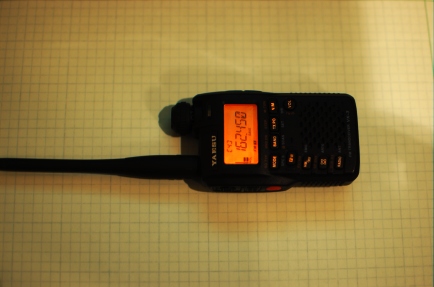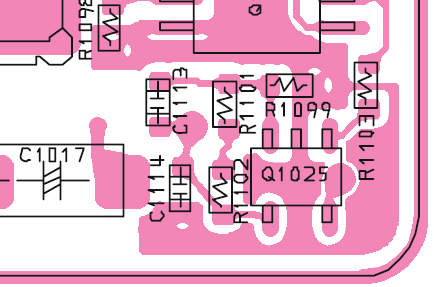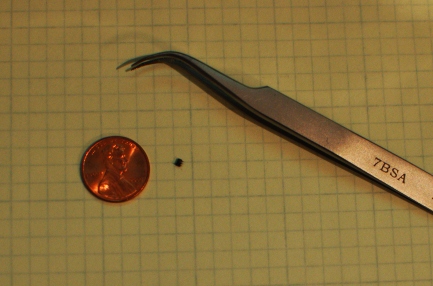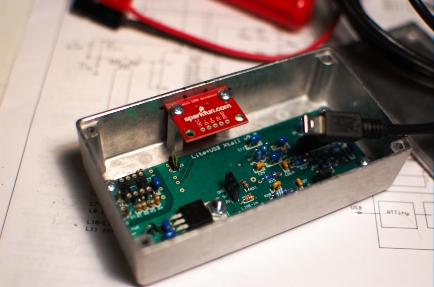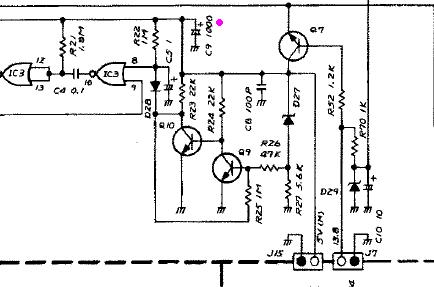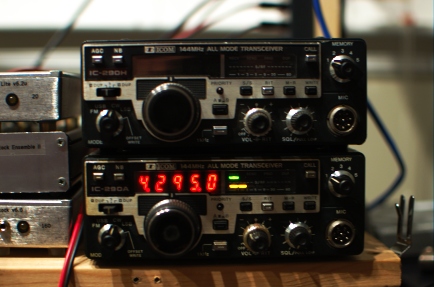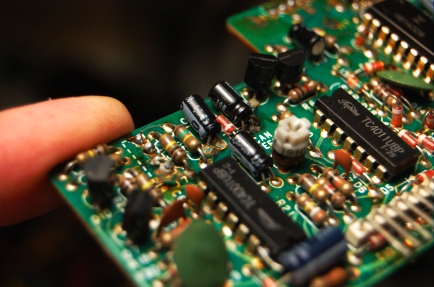Posts Tagged ‘repair’
 A deaf VX-3R
A deaf VX-3R
I do not spend a lot of time on VHF/UHF FM and have not for many years. My first radio in 1993 was an Alinco DJ-580T handheld and I’ve thought at various times that a new handheld might suit me well, especially for receiving. A few weeks ago, as I tend to, I came across a Yaesu VX-3R offered “for parts or repair” on attractive terms and so acquired it—my second handheld ever. The problem seemed straightforward enough: full TX power, but no RX on amateur bands. RX on FM broadcast OK. The seller assured me, after I had agreed to purchase based on his description, that “somebody” had told him that this problem occurs when “only one component is bad.”
Based on the seller’s description of the problem and a thorough reading of the Technical Supplement, I developed a short list of candidate failure modes, components, and sources. Fortunately, all of the components could be sourced easily from the usual sources.
When the radio arrived, I gave it a functional check and it indeed exhibited the problem that the seller had advertised. I quickly popped it open and noticed a small red sticker in the lower right-hand (when facing the device like you would operate it) corner of the Main Unit (Side A, per the Technical Supplement’s notation). A neatly hand-drawn arrow pointed to component Q1025, which upon closer inspection, was clearly damaged.
So, I quickly set about identifying the component and procuring a replacement. It was a NJU7007F3 operational amplifier. Huh…it did not contribute to any of the failure modes I had initially suspected. However, a careful reading of the Technical Supplement indicated that this op amp drives varactor diodes in a tracking preselector—so, if it does not work, the radio will exhibit varying degrees of deafness in the amateur bands. I found out later that the “somebody” was actually a Yaesu technician who had seen the radio for repair at the behest of a previous owner and left the sticker for me. At any rate, this component clearly would have to be replaced if I were to fix the radio, so I set about looking for a source.
Mouser listed it in their catalog but wanted me to buy a reel of 3000. No thanks. At least they had it listed. So, I did the next most logical thing—I made a list of other parts that I needed and called Yaesu. The part was back-ordered to Japan for 4-6 weeks, but only cost 0.42 USD. I bought three.
After however many weeks it has been, a package from Yaesu showed up on my doorstep tonight. After repairing a damaged PCB trace (non trivial on something this small), I was able to replace it. The little black speck in the middle of this photograph is the removed component. For my non-US readers, the US 0.01 USD coin (“Penny”) is about 19 mm in diameter.
The radio fired right up and received NOAA/NWS right away. The entire repair once I had the parts was about 30 minutes. There are still two unbuilt SoftRock kits, an IC-290A with an unlocking PLL, and W1GHZ transverters for 903 and 1296 to be worked on…maybe tomorrow…
 SoftRock v9.0 Lite+USB Xtall
SoftRock v9.0 Lite+USB Xtall
Brian, ND3F (aka N3IQ/R), gifted me a partially-complete SoftRock kit a few months ago on the condition that I put it on the air. I’m making some progress on that. I took this photograph to show the SparkFun USB break-out board installed in the Bud CU-124 enclosure. The whole thing is assembled now, but there is probably a solder bridge somewhere. This kit is going to be a lot of fun because it’s actually more flexible for experimenting than the present Ensemble II RX kit.
 More on IC-290A disappearing display
More on IC-290A disappearing display
See original post here. Convinced that I had it working, I put the IC-290A aside and worked on some other projects. But, when I came back to it a few weeks later, the display was still disappearing. So, armed with the schematic and the block diagram, I began narrowing it down.
The display digits and tuning A/D converter are both driven off the same bus. But, since the disappearance of the display did not bring loss of receive, that gave me some confidence that it was not affecting the synthesizer. In order to simplify the analysis, I elected to assume that it was a single component (almost certainly a cold solder joint or an electrolytic capacitor) at fault.
Another clue was that the VFO dial ceased to operate once the display started acting up. Taking the single-point-of-failure assumption into account, this strongly implicated the microprocessor on the LOGIC board as a starting point. The only suspicious device that I could find on the schematic was C9, a 1000-uF, 6.3-volt electrolytic capacitor on the Vcc line of the microprocessor. So, I replaced it with a similar value unit from my junk box.
And, the radio seems to be working…for now. I did park it on WA1ZMS/B overnight and it is still running.
 IC-290A disappearing display
IC-290A disappearing display
Regular readers know that I enjoy a good deal on a good project and just such an opportunity presented itself again recently, this time in the form of an Icom IC-290A, which is a 10-watt 144-MHz all-mode transceiver whose age rivals my own. It was from a large estate of much more valuable (think solid-state HF kilowatt, etc) items and the sellers were probably just happy to unload it since the display would come up at first but then disappear after a few minutes. After cleaning a film of nicotine residue off of case and knobs, I set to work diagnosing the problem.
I tuned into the two beacons that I can always hear: W3APL/B on 144.295 and WA1ZMS/B on 144.285. They sounded just as good as they did on the TS-700, the IC-290H, and the borrowed FT-736R. Then, the display went blank. But, I was tuned into WA1ZMS and I could still hear it just fine. Turning the main dial no longer changed the frequency. When I turned the radio off and back on, a clicking noise emanated from the speaker above the background hiss, but there was no receive and no display. Disconnecting the power supply and allowing the radio to sit for a few minutes restored normal operation…until the display blanked again. This seemed to me to be a thermal problem, perhaps a bad capacitor or two as I had found in a IC-290H obtained on similar terms.
I popped the cover off of the radio and immediately noticed a few dry/cold/oxidized solder joints on the “Sensor Unit” board that sits on the top of the radio behind the front panel.
In each case, the bad joints were associated with electrolytic capacitors. I desoldered all of them, cleaned the pads, and replaced the capacitors with new units. It was somewhat of a miracle that I had all of them in my junkbox.
The problem persisted and for a while I thought it was getting worse. For good measure, I went through all of the boards looking for leaky capacitors and cold solder joints and found nothing. The “Troubleshooting” section of the Service Manual was an abject waste of pulp, but I did go through it. The “PLL” (synthesizer) alignment section yielded no clues except that the reference oscillator (6.070 MHz nominally) level was a tad bit low in amplitude. I heeded the warning of the manual that it had been carefully adjusted at the factory and should not need adjustment. When the radio arrived, it was missing a number of case screws, suggesting that someone else had been inside. So, who knows what the Golden Screwdriver hath wrought!
After reseating the row of connectors at the front of the “Logic/PLL” board just behind the radio’s front panel, I noticed that the problem seemed to have vanished. It has not failed yet since doing that and replacing the Sensor board capacitors. I hooked the radio up to a Bird Termaline wattmeter borrowed from W3APL and it made 10 watts on FM and CW. The needle barely moved on a 10-watt full scale in USB. So, I need to verify if it’s the microphone or the radio. My new plan is to use this radio as the microwave IF and keep the more-powerful IC-290H for liaison and other portable purposes. So, USB operation is critical.
So, like I always say, it seems that there are a lot of repairs that can be done just by cleaning things up. I’m not totally satisfied with the technical explanation of why reseating those connectors seemed to have fixed the problem. But, that is what happened and it is consistent with a lack of communication between the encoder/display unit in the front of the radio and the microprocessor in the logic unit. It seems to be working for now!
Note (May 6th 2011): See update here.
